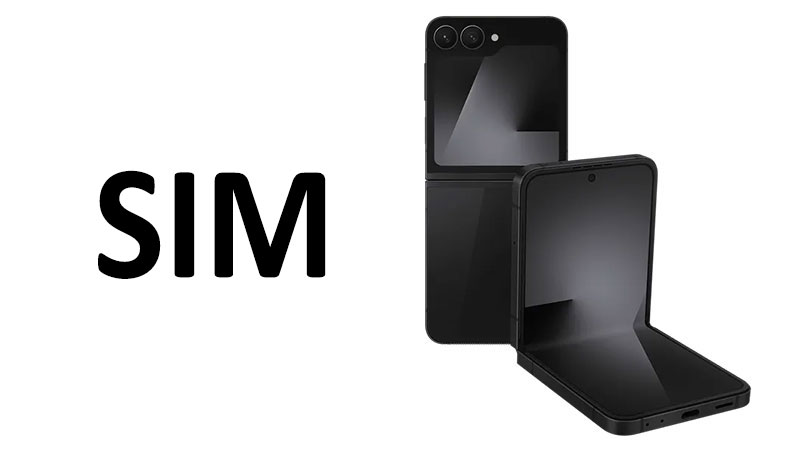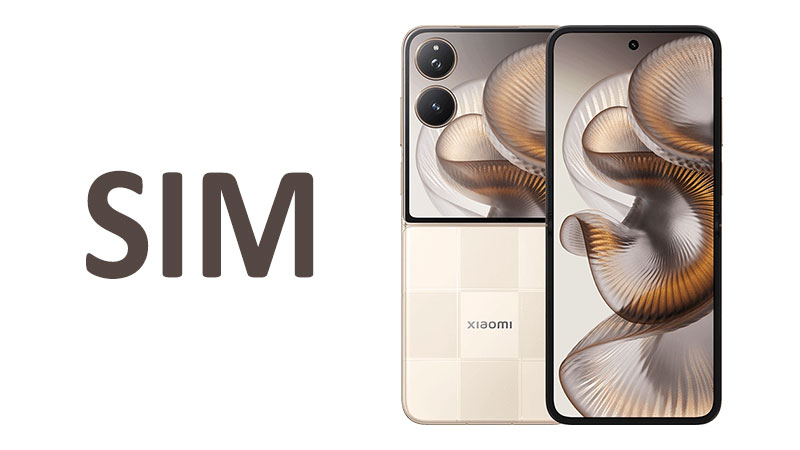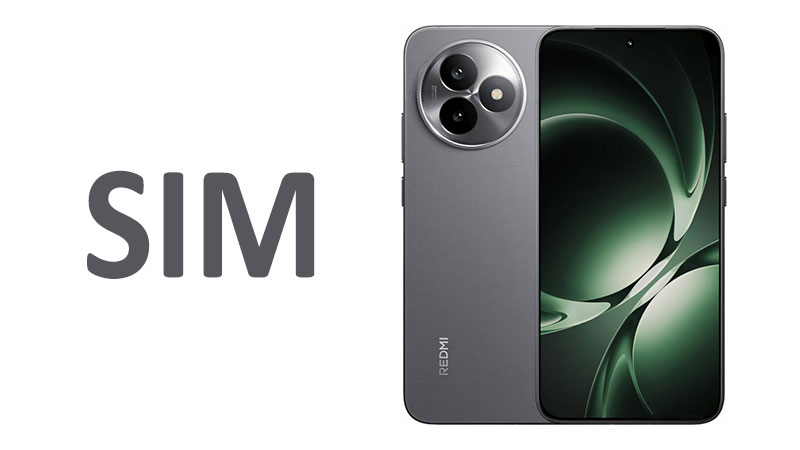The Samsung Galaxy Z Flip 7 SIM configuration sets the standard for modern foldable connectivity. This revolutionary clamshell phone is built around a highly flexible Dual-SIM system. It expertly combines a physical Nano-SIM slot with advanced eSIM capabilities. Understanding this connectivity matrix is essential for every potential owner. This extensive article will explore the Z Flip 7’s unique SIM options. It will also analyze its cutting-edge wireless and wired connections. The phone features next-generation Wi-Fi 7 and robust 5G support. This detailed review covers all technical aspects. It offers critical comparisons and important purchasing advice.
The Flexible SIM Architecture of the Galaxy Z Flip 7
The Samsung Galaxy Z Flip 7 SIM setup is optimized for the needs of modern, flexible users. It focuses on maximizing connectivity within a compact folding design. The configuration centers on a hybrid system. This system allows users to choose the best combination of physical and digital connectivity. This ensures flexibility for both travelers and those managing multiple lines.
Understanding the Nano-SIM and eSIM Combination
The Z Flip 7 primarily supports a configuration of Nano-SIM + eSIM + eSIM. Crucially, the device can only maintain a maximum of two active lines simultaneously. This means the user has several versatile options. They can choose to use the single physical Nano-SIM slot plus one active eSIM. Alternatively, they can use two different active eSIM profiles. The phone is also capable of storing multiple inactive eSIM profiles. This is indicated by the specification noting Nano-SIM + multiple eSIM. This high level of digital storage is a major convenience. It allows for quick switching between carrier plans without physically swapping cards.
The primary configuration in most markets utilizes this eSIM-centric approach. This strategy reflects the industry shift toward digital connectivity. It also helps conserve internal space within the tightly engineered folding chassis. This space savings contributes to a sleeker and more durable design.
Specialized Comparison: Z Flip 7 eSIM vs. Previous Models
Older flip models, like the Galaxy Z Flip 4 or 5, often supported only one physical SIM plus one eSIM. The Z Flip 7 enhances this capability significantly. By allowing the storage of multiple eSIM profiles, it greatly improves usability for international travelers. A traveler can download and store eSIMs for several different countries. They can activate and deactivate these plans instantly when they cross borders. Competitors in the foldable space might offer similar flexibility. However, Samsung’s widespread carrier partnerships ensure reliable eSIM provisioning globally. This ease of digital line management is a clear evolution from earlier generations.
Pros and Cons of the Flip 7’s SIM System
The main benefit is the sheer digital flexibility. Storing multiple eSIMs eliminates the common problem of lost or damaged SIM cards. It also makes switching between plans instantaneous. This is ideal for those who separate work, personal, and international lines. Furthermore, the hybrid nature still allows users to use a traditional physical Nano-SIM if needed. This is important in regions or for carriers that still lack full eSIM support.
The primary limitation is the maximum of two active lines. Although the phone can store many profiles, only two can function simultaneously. Also, users who prefer only physical dual-SIMs, common in some Asian markets, may be disappointed. They must utilize the eSIM functionality to achieve the full two-line capacity.
Important Points for Z Flip 7 Buyers
Potential buyers must confirm their carrier’s eSIM compatibility before relying entirely on the digital option. If the buyer frequently travels, they should plan to use the physical Nano-SIM for their primary, stable home line. They can reserve the eSIM functionality for quick, temporary international data plans. Understanding the simplicity of digital switching is key. It is a major workflow advantage for power users. This flexible setup maximizes convenience and minimizes hassle.
Next-Generation Mobile Speeds: 5G and Global Network Access
The Samsung Galaxy Z Flip 7 is engineered to operate on all major global networks. It supports GSM, CDMA, HSPA, EVDO, LTE, and the advanced 5G technology. This comprehensive compatibility ensures reliable service worldwide. The integration of high-speed 5G is paramount. It delivers the fast data transfer required by a premium device.
The Foundation of 5G and Global Compatibility
The primary connectivity engine is 5G. This technology provides drastically increased download and upload speeds. Crucially, it also delivers extremely low network latency. Low latency is essential for streaming high-resolution content and using cloud-based applications. The Z Flip 7’s modem supports both major types of 5G: sub-6 GHz and mmWave. Sub-6 GHz provides wide coverage and better penetration indoors. mmWave delivers ultra-fast, multi-gigabit speeds in dense urban areas. This dual capability ensures the fastest available speed in any location.
The continued support for CDMA and EVDO is also significant. This inclusion is mainly for the North American market. It guarantees compatibility with legacy networks. This makes the Z Flip 7 usable across virtually every carrier in the United States. Furthermore, the robust LTE (4G) support ensures seamless coverage. The phone drops to high-speed 4G smoothly when 5G is unavailable.
Specialized Comparison: Foldable Network Stability
Foldable phones present unique engineering challenges for antennas. The Z Flip 7 utilizes advanced antenna placement and material design. This ensures network stability is maintained whether the phone is open or closed. Earlier foldables sometimes struggled with signal strength in certain positions. The Z Flip 7 overcomes these issues. It achieves consistent signal quality comparable to a standard flagship. This stability is critical for voice calls and data integrity.
Pros and Cons of Network Technology
The immense advantage is the universal network compatibility. The Z Flip 7 works across all global mobile standards. The advanced 5G modem ensures blazing-fast data access. This significantly future-proofs the device against rapidly evolving network standards. The seamless, automatic switching between 5G and 4G ensures continuous, reliable service.
There are no real disadvantages to this robust network support. Samsung’s modems are highly efficient. They optimize battery life even when connected to high-speed 5G networks. Users simply benefit from the best possible speed available from their chosen carrier.
Extreme Wireless Access: Wi-Fi 6e and the Leap to Wi-Fi 7
The Samsung Galaxy Z Flip 7 features one of the most advanced WLAN specifications available. It includes support for Wi-Fi 802.11 a/b/g/n/ac/6e/7. It also maintains tri-band operation and Wi-Fi Direct. The inclusion of the next-generation Wi-Fi 7 standard is a headline feature.
Deconstructing the Wi-Fi 7 Advantage
Wi-Fi 7 (802.11be) is the latest and fastest wireless standard. It is designed for maximum data throughput. It can reach theoretical speeds far exceeding current fiber connections. A key feature of Wi-Fi 7 is Multi-Link Operation (MLO). MLO allows the Z Flip 7 to connect to different frequency bands simultaneously. It uses 2.4 GHz, 5 GHz, and 6 GHz bands combined. This dramatically increases both speed and connection reliability. It virtually eliminates sudden network drops. This ultra-fast, low-latency connection is essential for professional cloud gaming and high-resolution video streaming.
The Role of Wi-Fi 6e and Tri-Band
The phone also supports Wi-Fi 6e. This standard utilizes the clean, uncongested 6 GHz frequency band. This provides wide channels and minimal interference. It guarantees stable, high-speed performance even in crowded wireless environments. Tri-band operation means the phone can automatically select the best connection. It chooses between the long-range 2.4 GHz, the fast 5 GHz, and the ultra-fast 6 GHz bands. This ensures peak performance regardless of distance from the router. Wi-Fi Direct also provides simple peer-to-peer file sharing capability.
Specialized Comparison: Wi-Fi 7 vs. Current Flagships
Most current flagships support only Wi-Fi 6e. The Z Flip 7’s inclusion of Wi-Fi 7 provides a significant long-term advantage. Wi-Fi 7 routers are still rolling out. However, the Z Flip 7 is ready to utilize their full potential immediately. When connected to a Wi-Fi 7 router, the phone can achieve multi-gigabit speeds. This performance is currently unmatched by devices limited to Wi-Fi 6e. The Z Flip 7 is built to handle the future demands of ultra-high-bandwidth wireless applications.
Pros and Cons of WLAN Implementation
The advantages are clear: the Z Flip 7 is future-proofed with Wi-Fi 7. It also maintains excellent current performance using Wi-Fi 6e. The tri-band support ensures connectivity stability and maximum speed. This is arguably the best wireless setup available in any smartphone.
The main constraint is the infrastructure requirement. Users need a Wi-Fi 7 router to experience the full potential of MLO and peak throughput. The phone will still perform excellently on Wi-Fi 6e or older networks. The cost of new Wi-Fi 7 routers is an external investment the user must make.
Short-Range Connectivity: Bluetooth 5.4 for Superior Audio
The Samsung Galaxy Z Flip 7 features the latest Bluetooth 5.4 standard. This is the top-tier technology for short-range wireless communication. Bluetooth 5.4 manages all connections to the user’s wearables and audio devices.
Deep Dive into Bluetooth 5.4 Features
Bluetooth 5.4 introduces crucial advancements in efficiency and capability. It significantly enhances the Bluetooth Low Energy (LE) profile. This results in longer battery life for both the Z Flip 7 and connected accessories. It is also required for supporting LE Audio technology. LE Audio is the next generation of wireless audio. It promises better sound quality and more stable connections.
The device supports A2DP (Advanced Audio Distribution Profile). This ensures high-quality stereo audio streaming. The inclusion of Bluetooth 5.4 positions the Z Flip 7 for future innovations. These include Auracast broadcast audio. Auracast allows the phone to broadcast sound to an unlimited number of nearby compatible devices. This has vast potential for shared listening experiences in public spaces.
Specialized Comparison: Bluetooth 5.4 vs. Bluetooth 5.3
Most devices released a year prior featured Bluetooth 5.3. Bluetooth 5.4 provides subtle but important refinements. It offers better power management and is fully specified for all LE Audio features. The difference is primarily in long-term efficiency and future feature support like Auracast. The Z Flip 7’s 5.4 implementation is future-ready. It guarantees the best possible audio experience with all high-end wireless headphones.
Pros and Cons of Bluetooth Implementation
The major advantage is the efficiency and readiness for LE Audio. Users will experience longer battery life from their earbuds. They will also get superior, high-quality wireless sound. The stability of the 5.4 standard ensures reliable connections.
The main disadvantage is that the full benefits depend on compatible accessories. Users need new LE Audio-ready earbuds or headphones to utilize the technology fully. However, the phone remains fully backward-compatible. This means all older Bluetooth accessories will connect without issue.
Precision Positioning: Comprehensive GNSS Support
Accurate location tracking is necessary for all mobile devices. The Samsung Galaxy Z Flip 7 features a highly capable Global Navigation Satellite System (GNSS) suite. It supports five concurrent systems for maximum accuracy. These include GPS, GALILEO, GLONASS, BDS, and QZSS.
Multi-System Positioning for Reliability
The phone uses signals from all five systems simultaneously. This multi-GNSS approach provides exceptional reliability.
- GPS is the original US system.
- GALILEO is the robust European system.
- GLONASS is the reliable Russian system.
- BDS is the Chinese BeiDou system.
- QZSS is the Japanese regional system.
By receiving signals from numerous satellites, the phone achieves a very fast location lock. It also minimizes location errors caused by signal blockage. This is critical for reliable navigation in deep city environments. It also provides accurate data for fitness tracking applications.
Specialized Comparison: GNSS Accuracy
The Z Flip 7 is expected to utilize advanced dual-frequency GNSS in certain bands. This is common in high-end Samsung devices. Dual-frequency (L1+L5) positioning significantly reduces atmospheric interference. It ensures centimeter-level accuracy in ideal conditions. This is a substantial improvement over the meter-level accuracy of older, single-frequency phones. This precision is vital for augmented reality and high-detail mapping.
Physical and Auxiliary Connections: USB, NFC, and Radio
The Z Flip 7 completes its connectivity profile with necessary physical and auxiliary features. These enhance the device’s daily utility and data management.
High-Speed USB Type-C 3.2 and OTG
The Samsung Galaxy Z Flip 7 is equipped with a USB Type-C 3.2 port. This standard is significantly faster than the common USB 2.0 found in many older phones. USB 3.2 enables rapid data transfer. This is necessary for moving large photos and video files off the phone quickly.
The port also fully supports On-The-Go (OTG) functionality. OTG allows the Z Flip 7 to act as a host device. Users can directly connect external peripherals. These include flash drives, keyboards, and other accessories. This feature adds significant functional flexibility for data management on the go.
NFC for Contactless Utility
Near Field Communication (NFC) is standard on the Z Flip 7. NFC enables secure and fast contactless mobile payments. Users can pay simply by tapping their folded phone at compatible terminals. This convenience is a modern necessity. NFC also facilitates quick, simple pairing with wireless devices. It supports localized data exchange between two phones easily.
A Note on the Absence of Radio
The specifications confirm the absence of an integrated FM radio tuner. This is now an industry-standard exclusion for premium smartphones. Consumers overwhelmingly prefer internet-based streaming for music and radio content. The Z Flip 7’s fast 5G and Wi-Fi 7 connectivity ensures flawless digital streaming. The lack of a physical FM tuner is irrelevant for the vast majority of modern users.
Overall Connectivity Pros, Cons, and Buyer Points
The Samsung Galaxy Z Flip 7 connectivity is built for maximum speed and convenience. It is a highly robust and future-proof system.
Key Connectivity Advantages
- Hybrid Dual-SIM Flexibility: The combination of Nano-SIM and multiple stored eSIMs offers ultimate line management convenience. This is perfect for global travel.
- Next-Gen Wi-Fi 7: This is a major future-proofing feature. It provides unparalleled speed and stability through Multi-Link Operation (MLO).
- Advanced Bluetooth 5.4: Ensures superior power efficiency and readiness for LE Audio and future Auracast functionality.
- High-Speed 5G: Provides consistent access to the fastest mobile data speeds globally, including essential CDMA compatibility.
- USB 3.2 OTG: Enables rapid file transfers and allows direct connection to external storage and peripherals.
Key Connectivity Trade-offs
- Two Active Lines Maximum: The phone can only run two lines simultaneously, even with many eSIMs stored.
- Wi-Fi 7 Router Required: The full benefits of Wi-Fi 7 require the user to purchase a compatible router.
- No Dual Physical SIM: Users who require two physical SIM slots will need to use the eSIM feature for dual line functionality.
Essential Points a Buyer Should Know
The SIM flexibility is the core feature here. Buyers should embrace the eSIM capability. It is the most convenient way to manage temporary or secondary lines. The inclusion of Wi-Fi 7 means the phone is prepared for the next wave of home networking upgrades. This offers a clear long-term benefit. Finally, the USB 3.2 port supports rapid file transfers. This is necessary for moving large video files captured by the phone’s advanced cameras. The Z Flip 7 is a premium, compact device that makes zero compromises on connectivity speed.
Conclusion: Making an Informed Connectivity Choice
The Samsung Galaxy Z Flip 7 SIM and connectivity package is exceptional. It perfectly balances the demands of a premium foldable phone. The Nano-SIM + multiple eSIM configuration is highly effective. It maximizes line management flexibility for every type of user. The phone’s speed is guaranteed by the dual threat of fast 5G and the future-proof Wi-Fi 7 standard.
Furthermore, the Z Flip 7 utilizes Bluetooth 5.4 for elite audio performance. The USB 3.2 port ensures fast physical data handling. This device is ready for the next five years of network evolution. The Z Flip 7 is an easy recommendation for anyone. It needs the convenience of a compact foldable. It also requires the uncompromising speed and versatility of a full-fledged flagship.
Frequently Asked Questions (FAQ)
1. How many physical SIM cards can I use in the Samsung Galaxy Z Flip 7?
The Z Flip 7 has one physical Nano-SIM slot. The second active line must be an eSIM. The phone can store multiple eSIM profiles for easy switching.
2. Is the Wi-Fi 7 feature immediately useful without a new router?
Yes, the phone supports Wi-Fi 6e on the clean 6 GHz band. This provides excellent speed and low latency today. The Wi-Fi 7 hardware future-proofs the phone for when you eventually upgrade your router.
3. What is the main benefit of the USB Type-C 3.2 port for this phone?
The USB Type-C 3.2 port provides high-speed data transfer. This is essential for quickly backing up or transferring large photo and video files off the phone.
4. Does the Galaxy Z Flip 7 still support older US carrier networks like CDMA?
Yes, the specifications confirm full support for GSM, CDMA, and EVDO. This ensures the Z Flip 7 is fully compatible with all major US mobile carriers.
5. Why is Bluetooth 5.4 important for a compact device like the Z Flip 7?
Bluetooth 5.4 offers enhanced power efficiency (LE Audio). This allows the Z Flip 7 to conserve battery life. It also ensures superior quality when streaming audio to wireless accessories.



